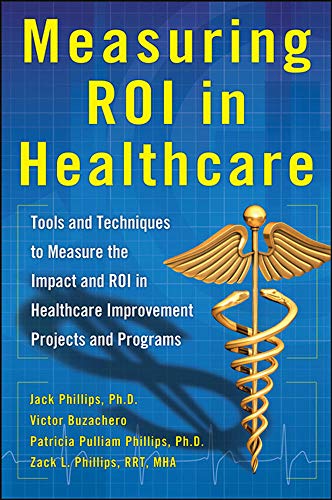



Full description not available
B**N
Unfocused, superficial, and riddled with unfounded claims
Let me first get this out of the way: The authors have built a business that builds on someone else's work without even once acknowledging this. The four level framework is clearly Kirkpatrick's model for evaluating training, and what little information they provide about the ROI piece is also not original. For sure, they are not the first consultants to use someone else's work to make money, but have the decency to credit that person.Every chapter starts with a few case studies or opening stories. That's great. I love that! Unfortunately, none of the stories provide any level of detail about what actually happened. Everything is described in vague terms and sometimes appear to have little bearing on the chapter within which they were placed.The authors struggle to stay focused on the task at hand (as stated in the title): Measuring the impact and ROI of healthcare improvement projects and programs. Too often they veer off and start discussing how to execute improvement projects, something they clearly are not skilled at. Most comically, they repeatedly recommend performance contracting, a favorite tool of the New Public Management school that has had tremendous negative impact on the public sector by its idiotic belief that it can be operated as a company.For a book that wants to talk about measurement, there is surprisingly little practical guidance on how to measure anything. Over and over, the same vague points are repeated, and the reader is left wondering if the authors even know what measurement means. The chapter on calculating ROI is woefully inadequate and again provides almost not guidance on the how.The notes are so few that it is an embarrassment. Chapter 4 about measuring reaction and learning (Kirkpatrick level 1 and 2, even if the authors forget to give the credit) has two notes. One is a link to the 2011 United Nations Millennium Development Goals Report (what the what?); the other is a reference to a 1999 article in Management Review about how "Today's competitive edge comes from intellectual capital". Really? You're citing that in a book published in 2013 like you just had a revelation. Nowhere to be found is a reference (even one!) to this bold claim on page 106-107 of the hardcover version: "Reaction data can be used to predict application of a project using analytical techniques. In a follow-up, project participants provide input on effectiveness of the project's application, and the data are compared to the reaction data. A significant correlation between the two indicates a causal chain, and the reaction data become a forecast. [...] Countless studies have been conducted to verify this correlation and causation."Excuse my French for a second, but that's a pile of horse manure. Correlation between two variables in an observational study may be indicative of causation, but only a carefully planned study can demonstrate that. It's scientific thinking 101. And no, there are not countless studies that verify this. It's one of the most important critiques of the Kirkpatrick model that basically no studies have been able to demonstrate a causal relationship between the 4 levels of the model.Bottomline: A bunch of grifting management consultants slapped together their notes. There's nothing original to "The ROI Methodology®" (what idiot issued them a trademark for this generic approach that is part stolen goods, part centuries old practice?). You would be better off reading one of the many freely available overviews of the Kirkpatrick model and a textbook on health economics.
D**N
Diverse approaches to evaluating the impact and value of interventions in healthcare
Another fine book from the Phillips and colleagues. If you work in healthcare and need to demonstrate the value of interventions with sound evidence this book will provide you with the methodology and I highly recommend it. On the other hand if, like me, you are already familiar with the ROI methodology and work in healthcare, I’ll suggest this book would still be a worthwhile addition to library. First, the healthcare specific case examples are helpful for understanding how others have applied these methods in similar organizations. Second, I think it is also important to be able to show stakeholders that are multiple approaches to reaching an answer to questions of impact and value. For example, many stakeholders will be familiar with experimental approaches to determining the impact of a program; other approaches, such as estimates are not generally known. The book as a whole and the chapter on isolation of project impact in particular can provide stakeholders with evidence that this is a credible and widely applied methodology that is relevant in healthcare.
M**N
Cuts to the specific points in this space
I have been selling into healthcare since the mid 90's. I have seen this space evolve. They have different measures for ROI in some respects and of course many are similar. This book uses case studies and facts that can serve as starting point for you to build consensus when going after a project (purchase) in the HC space.
Trustpilot
1 month ago
3 weeks ago